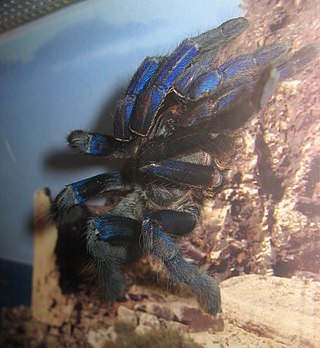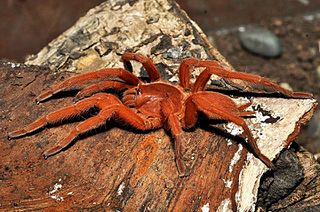
Brachypelma smithi is a species of spider in the family Theraphosidae (tarantulas) native to Mexico. It has been confused with Brachypelma hamorii; both have been called Mexican redknee tarantulas. Mexican redknee tarantulas are a popular choice as pets among tarantula keepers. Many earlier sources referring to B. smithi either relate to B. hamorii or do not distinguish between the two species. B. smithi is a terrestrial tarantula native to Pacific coast of the Mexican state of Guerrero.

Ornithoctoninae is a subfamily of tarantulas found in Southeast Asia. It was first erected in 1895 by Reginald Innes Pocock based on the type specimen Ornithoctonus andersoni.

Cyriopagopus schmidti is a species of spider in the family Theraphosidae (tarantulas), found in China and Vietnam. It is one of a number of species known as "Chinese bird spider" and "Chinese earth tiger". Haplopelma huwenum was synonymized with this species in 2008. Spiders under this name and its synonyms have been shown to produce toxins called huwentoxins.

Selenocosmia is a genus of tarantulas that was first described by Anton Ausserer in 1871. The genus is found in China, New Guinea, Indonesia, Australia, Indonesia, Myanmar, Malaysia, Laos, Vietnam, Philippines, India and Pakistan. They are commonly referred to as whistling or barking spiders, due to their ability to stridulate using lyra hairs.

Psalmopoeus is a genus of the family Theraphosidae containing various species of tarantulas. The genus is native to Trinidad and Tobago, Colombia, Ecuador, Venezuela, Guyana, Brazil, Belize, Panama, Nicaragua, Costa Rica, Mexico, Guatemala and Honduras. All of these tarantulas are arboreal in nature, Psalmopoeus victori being the first arboreal tarantula of Mexico.

Tarantulas comprise a group of large and often hairy spiders of the family Theraphosidae. As of August 2022, 1,040 species have been identified, with 156 genera. The term "tarantula" is usually used to describe members of the family Theraphosidae, although many other members of the same infraorder (Mygalomorphae) are commonly referred to as "tarantulas" or "false tarantulas". Some of the more common species have become popular in the exotic pet trade. Many New World species kept as pets have setae known as urticating hairs that can cause irritation to the skin, and in extreme cases, cause damage to the eyes.

The skeleton tarantula, Ephebopus murinus, is a species of spider belonging to the family Theraphosidae (tarantulas), sub-family Aviculariinae. A New World species, it is native to several South American countries. Its common name is derived from the skeleton-like markings on its legs.

Cyriopagopus is a genus of southeast Asian tarantulas found from Myanmar to the Philippines. As of March 2017, the genus includes species formerly placed in Haplopelma. It was first described by Eugène Louis Simon in 1887.

Ephebopus cyanognathus, known as the blue fang tarantula, is a species of tarantula. It is endemic to French Guiana. It was first described by Rick C. West and Samuel D Marshall in 2000, and is somewhat commonly kept as pets. As it common name may suggest, they have magnificent blue chelicerae, cyano meaning blue and gnathus meaning jaw. This tarantula is a burrowing spider, though spiderlings of this species have been observed to be semi-arboreal.

Orphnaecus is a genus of tarantulas that was first described by Eugène Louis Simon in 1892. They have close to fifty lanceolate stridulatory spines on the chelicerae, known as "strikers". The male embolus has a single strong retrolateral keel. It is considered a senior synonym of Chilocosmia and Selenobrachys.

Orphnaecus philippinus, known as the Philippine Tangerine, Philippine Orange, or Neon Orange Tarantula is a species of tarantula. It is native to the Philippines. It was described in 1999, by Gunter Schmidt, as Selenobrachys philippinus, but in 2012, Rick West, Steven Nunn and Henry Hogg made the genus Selenobrachys a junior synonym of Orphnaecus.

Phlogiellus is a genus of tarantulas that was first described by Reginald Innes Pocock in 1897. They are found throughout Asia and Papua New Guinea, including Indonesia, the Philippines, Papua New Guinea, China, Myanmar, Malaysia, Borneo, Thailand, the Solomon Islands and Taiwan. Phlogiellus is part Latin and part Greek, the first part being "φλóξ φλoγóϛ", meaning flame, the second part being "ellus" which is a latin diminutive suffix.
Coremiocnemis is a genus of tarantulas that was first described by Eugène Louis Simon in 1892. They are named after the greek words korema, which means broom or brush, and kemis, meaning shin guard. Being a reference to the hirsute characteristics of the posterior legs.

Haplocosmia is a genus of Asian tarantulas that was first described by Günter E. W. Schmidt & V. von Wirth in 1996. As of March 2020 it contains three species, found in Nepal, Himalayas and Tibet: H. himalayana,H. nepalensis and H. sherwoodae.
Psednocnemis is a genus of Southeast Asian tarantulas that was first described by R. C. West, S. C. Nunn & Henry Roughton Hogg in 2012.

For the sexologist, psychotherapist, and social psychologist, see Gunter Schmidt.
Rick C. West is a Canadian arachnologist and an expert on the taxonomy of tarantula spiders. West was born in Victoria, British Columbia. He has been interested in spiders since childhood, and collected his first tarantula, Aphonopelma eutylenum, at the age of 13. He worked primarily as a Chief Constable for a local Animal Humane Society, but also have been involved with the collecting, breeding, rearing and photography of theraphosid spiders. West has traveled to over 27 countries to document and study them in their environment, has been a host, presenter and co-producer in several tarantula documentaries and has also described several genera and species.
Sandinista lanceolatum is a species of spider in the family Theraphosidae (tarantulas), native to Nicaragua and Costa Rica.

The Selenocosmiinae are a subfamily of tarantulas found throughout South-East Asia and Australia. This subfamily is defined by the presence of a lyra on the maxillae and strikers on the chelicerae, allowing these spiders to stridulate and produce a "hissing" sound. However some species within Phlogiellus may have secondary lost their lyra but retain their strikers. The monophyly of the subfamily has been only tested using genetic data with a handful of genera or species in a few studies. However, these studies found genera that had been previously placed in this subfamily were actual their own separate subfamily (Poecilotheria) and that Selenocosmiinae is most closely related to the Indian Thrigmopoeinae. As of 2021, Selenocosmiinae contains 11 genera.













